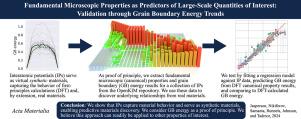基本微观性质作为大尺度量的预测:通过晶界能量趋势的验证
IF 8.3
1区 材料科学
Q1 MATERIALS SCIENCE, MULTIDISCIPLINARY
引用次数: 0
摘要
从第一原理可计算的基本微观性质(我们称之为规范性质)与复杂的大尺度感兴趣量(qoi)之间的相关性为预测材料的发现提供了一条途径。我们提出这种相关性可以通过利用近似原子间势(IPs)的模拟有效地发现,它作为“合成材料”的集合。作为原理证明,我们建立了一个回归模型,将正则性质与面心立方晶体中的对称倾斜晶界(GB)能量曲线联系起来,以Runnels等人(2016)的通用晶格匹配模型中的比例因子为特征,我们将其作为我们的qi。我们的分析恢复了已知的GB能量与其他性质的相关性,并发现了新的相关性。我们还利用现有的密度泛函理论(DFT) GB能量数据证明,由IP数据构建的回归模型与DFT结果一致,证实了IP和DFT属于同一统计池的假设,从而验证了该方法。以这种方式构建的回归模型可用于基于第一性原理数据的大规模qos预测,并为第一性原理计算范围之外的qos训练ip提供了一种通用方法。本文章由计算机程序翻译,如有差异,请以英文原文为准。


Fundamental microscopic properties as predictors of large-scale quantities of interest: Validation through grain boundary energy trends
Correlations between fundamental microscopic properties computable from first principles, which we term canonical properties, and complex large-scale quantities of interest (QoIs) provide an avenue to predictive materials discovery. We propose that such correlations can be efficiently discovered through simulations utilizing approximate interatomic potentials (IPs), which serve as an ensemble of “synthetic materials”. As a proof of principle we build a regression model relating canonical properties to the symmetric tilt grain boundary (GB) energy curves in face-centered cubic crystals, characterized by the scaling factor in the universal lattice matching model of Runnels et al. (2016), which we take to be our QoI. Our analysis recovers known correlations of GB energy to other properties and discovers new ones. We also demonstrate, using available density functional theory (DFT) GB energy data, that the regression model constructed from IP data is consistent with DFT results, confirming the assumption that the IPs and DFT belong to same statistical pool and thereby validating the approach. Regression models constructed in this fashion can be used to predict large-scale QoIs based on first-principles data and provide a general method for training IPs for QoIs beyond the scope of first-principles calculations.
求助全文
通过发布文献求助,成功后即可免费获取论文全文。
去求助
来源期刊

Acta Materialia
工程技术-材料科学:综合
CiteScore
16.10
自引率
8.50%
发文量
801
审稿时长
53 days
期刊介绍:
Acta Materialia serves as a platform for publishing full-length, original papers and commissioned overviews that contribute to a profound understanding of the correlation between the processing, structure, and properties of inorganic materials. The journal seeks papers with high impact potential or those that significantly propel the field forward. The scope includes the atomic and molecular arrangements, chemical and electronic structures, and microstructure of materials, focusing on their mechanical or functional behavior across all length scales, including nanostructures.
 求助内容:
求助内容: 应助结果提醒方式:
应助结果提醒方式:


